by Leanne E. Smith
“The rainy weather cooperated with us,” Karen Lovejoy joked the Saturday before Easter 2015 during the First Annual Clam Chowder Cook-off on Ocracoke Island that showcased four entries in the Ocracoke-traditional category and seven for non-traditional. The mid-day event was a fundraiser for the Ocracoke Childcare Center, also known as the “Little School,” for which Lovejoy is a board member and of which her two children are alumni. The idea of a clam chowder cook-off came from Ruth Toth, who owned Café Atlantic with her husband Bob before they retired in 2013. When she heard the Childcare Center recently had to close and reorganize for a smaller budget, she felt the situation was a community crisis and started volunteering with the OCC, which fulfills childcare needs outside of the pre-K and afterschool programs connected to the local public school. The fundraiser organizers didn’t know if the cook-off would work. Would they have any entries? Would anyone show up? Yes—for both questions.
Eleven individuals, organizations, and businesses entered about 35 gallons of clam chowder, and in a community of approximately 1,000 year-round residents, more than 160 tickets were sold. Toth was “thrilled” and observed that the crowd at the Ocracoke Community Center was a “nice mix of tourists and locals.” For $10, attendees got a Chowder Taster sticker, granting them access to sample as many of the chowders they chose to try, and a ballot to vote for their favorite traditional and nontraditional chowders. Hot dogs were also available for anyone who isn’t yet a fan of clam chowder or who might have seen too much of it while making it for the fundraiser. OCC volunteers also hosted a bake sale and a raffle for an Ocracoke fig cake, a hummingbird cake, and a chocolate layer cake. Recorded music by local band Molasses Creek played on a sound system from the stage where the drum kit and other equipment waited for the evening dance with the Ocracoke Rockers, which was also part of the day’s fundraiser.
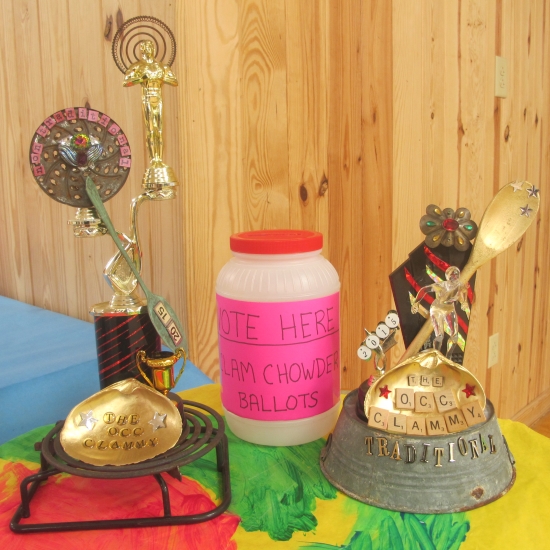
Photo: Leanne E. Smith.
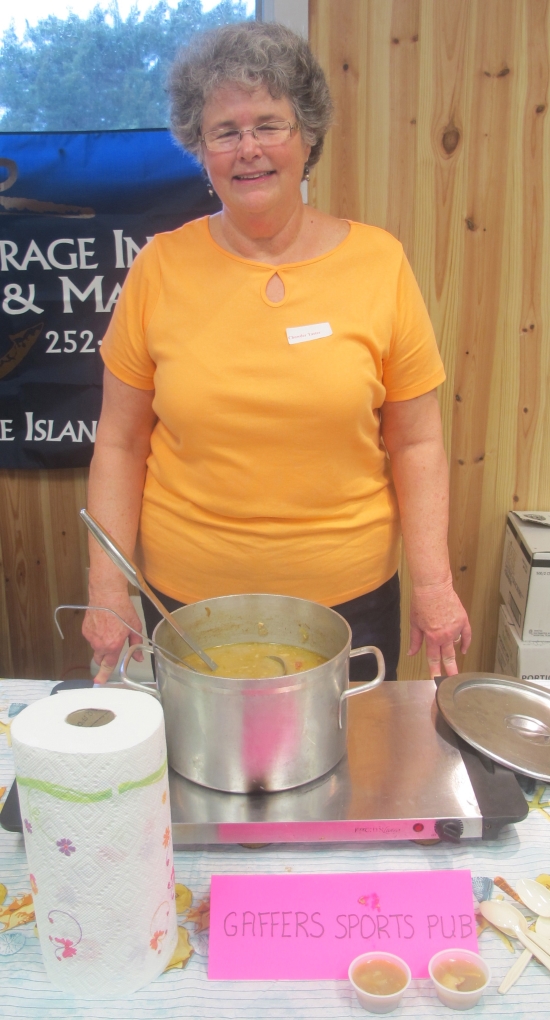
Photo: Leanne E. Smith, 4-4-2015.
In pre-event publicity, Toth differentiated traditional Ocracoke clam chowder from other versions: “Traditional means the only ingredients allowed are clams and their juice, water, potatoes, onions, salt pork or bacon, salt and pepper. Pepper vinegar and hot sauce may be used as condiments. ‘The inclusion of any other ingredients is considered non-traditional’” (“Clam”). The four entrants in the traditional category were the Ocracoke Preservation Society, Ocracoke Volunteer Fire Department, the post office staff, and Gaffer’s Sports Pub; the seven in the non-traditional category were Anchorage Inn & Marina, Ocracoke Oyster Company, Dick Tunnel, Sharon Brodisch, Jason’s Restaurant, WOVV 90.1 FM, and Fess Winstead.
In response to a “what makes yours special” question, Sherry Atkinson of the Anchorage Inn & Marina quickly said, “Love! With the loving pot, it’s always good.” And all of the chowders were indeed good—different from each other, and all tasty and representative of place, maker, or both. The clams were as local as possible—gathered personally or purchased from either Native Seafood or the Ocracoke Working Watermen’s Association’s retail fish house Ocracoke Seafood. Toth noted that “Ocracoke has the best clams” because clams, like all shellfish, need clean salt water—and the village’s proximity to the constant flux between the Pamlico Sound and Atlantic Ocean via Ocracoke Inlet helps make better clams.
Shucking clams can take a long time, especially when making a few gallons of chowder that may use 300 clams. One trick contemporary technology has allowed for is freezing clams overnight so the adductor muscles relax, and since the juice is frozen, less is lost. Clam texture varied in the different chowders or within one pot—some whole if small enough, some chopped, some nearly pureed. Potatoes and onions, and usually another meat and spices, were common across the traditional and nontraditional entries, with varying degrees of dicing and different choices about peeling the potatoes or including the skins. From there, the chowders varied. While not the Ocracoke style, the nontraditional category’s variations included other regional elements or represented other traditions with which the makers were personally familiar. Ingredients lists in the captions with the photos below are included as they were written on signs with the chowder pots.
Traditional Category
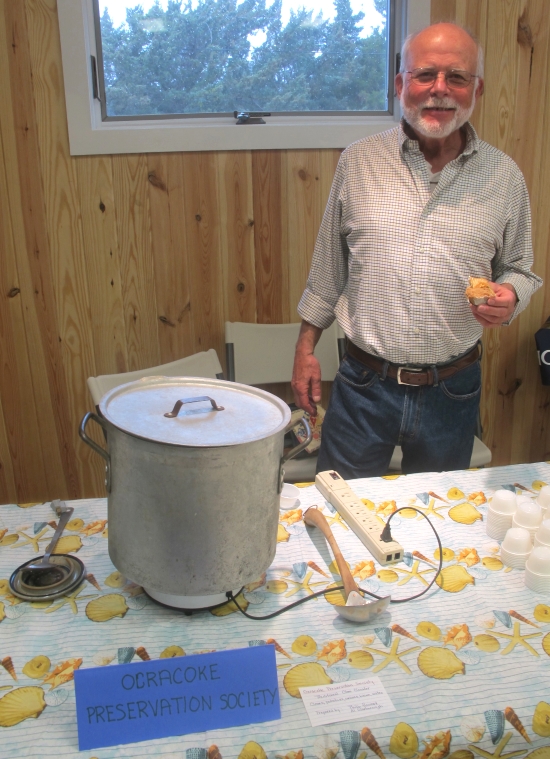
Photo: Leanne E. Smith.
Philip Howard, who is descended from several generations of Island residents, joked that there was “Nothing!” special about his chowder—it was just traditional. But that’s exactly what was special about his version. His, and the other traditional entries exemplified the combination of ingredients long associated with the Island: clams, potatoes, onions, water, and some kind of cured pork. For the broth-based Ocracoke chowder, measuring ingredients is a question of personal choice. Howard doesn’t. He’ll typically start with water and then add ingredients to fit the proportion set by the amount of water. For today’s chowder, he started with about a gallon of water and used about 7.5 pounds of potatoes to make approximately three gallons of finished chowder. Texture-wise for clams, he uses a blender to make “clam mush.”
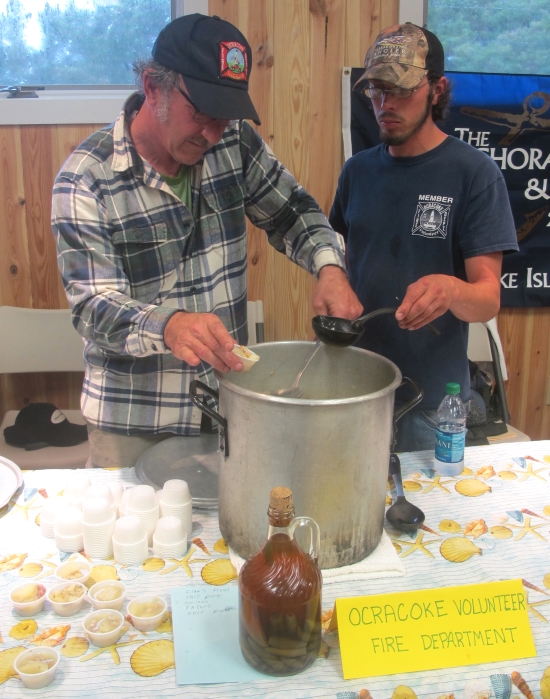
Photo: Leanne E. Smith, 4-4-2015.
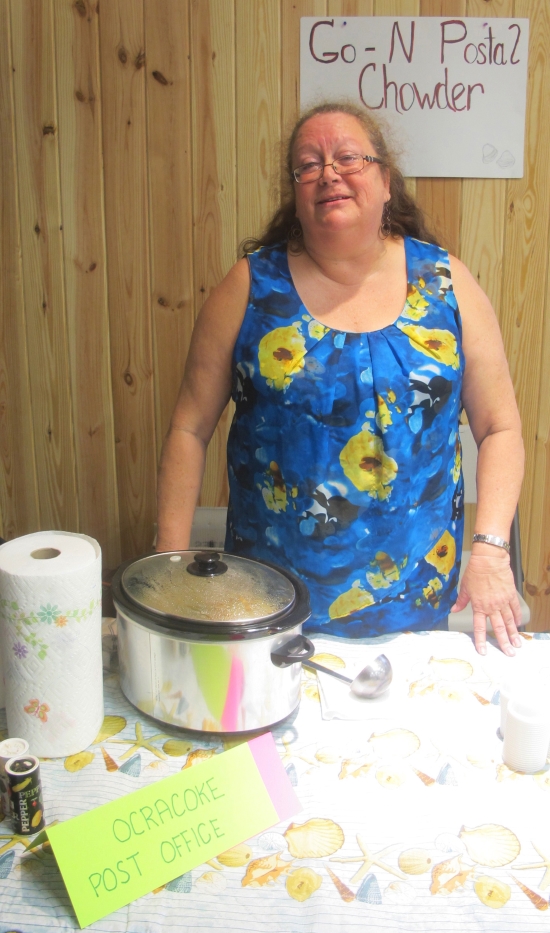
Photo: Leanne E. Smith, 4-4-2015.
Non-Traditional Category
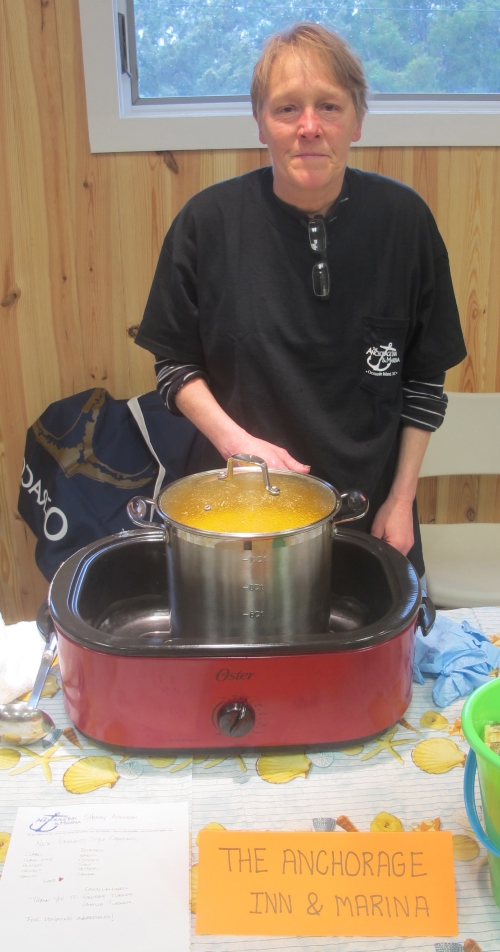
Photo: Leanne E. Smith, 4-4-2015.
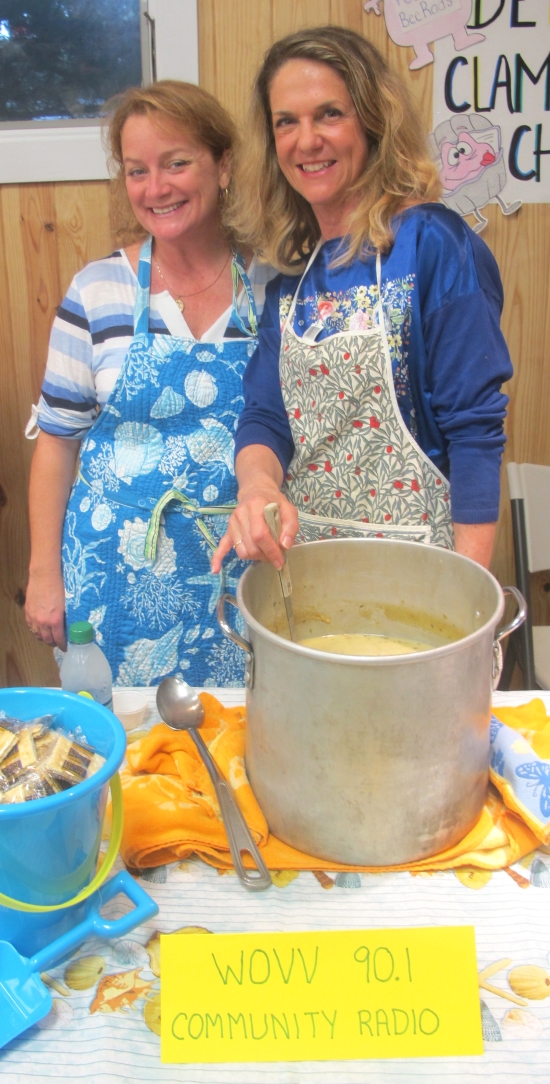
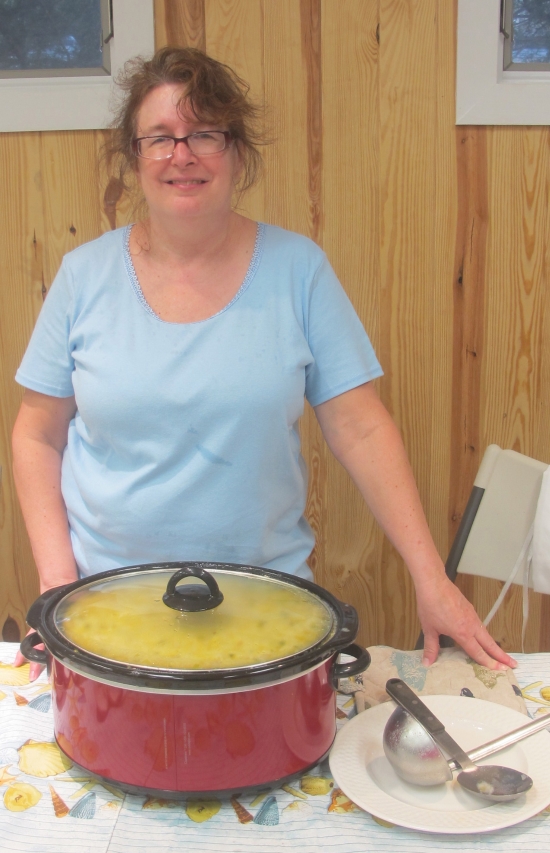
Photo: Leanne E. Smith, 4-4-2015.
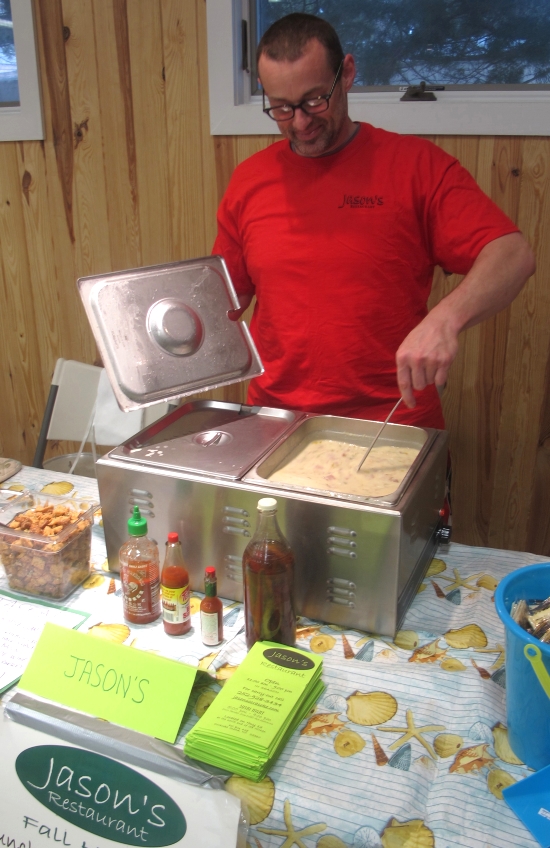
Photo: Leanne E. Smith, 4-4-2015.
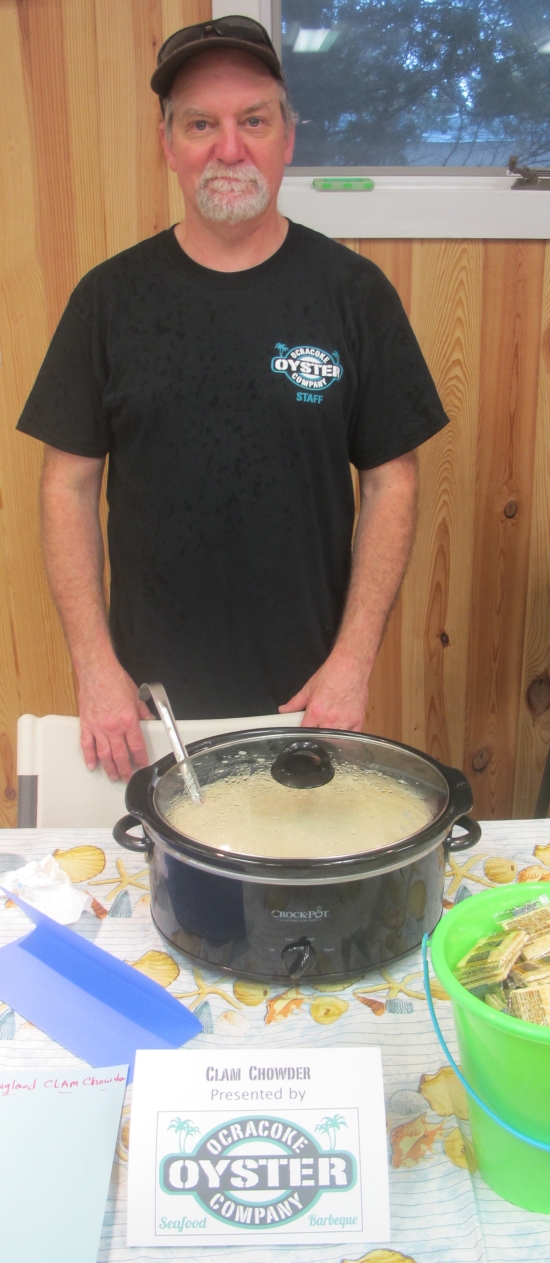
Photo: Leanne E. Smith, 4-4-2015.
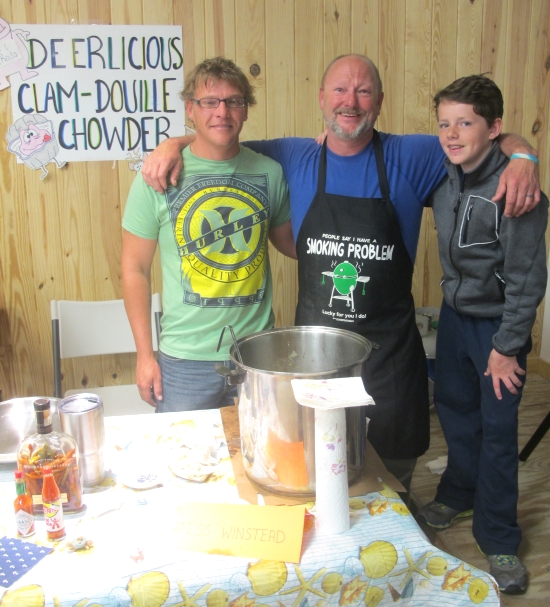
Photo: Leanne E. Smith, 4-4-2015.
Fess Winstead previously won a chili cook-off fundraiser for the Childcare Center. Today, he wore his apron reading, “People say I have a smoking problem–lucky for you I do.” Growing up on a farm gave him exposure to hog killings, and today he says, “We definitely eat our share of wild game.” He now combines his farming and hunting influences to make his own sausage. He says, “I like my food simple…I like for my food to speak for itself,” though the way he describes his ingredients shows he carefully considers his flavor combinations. For some of his stews, chilies, and chowders, he uses bear meat, but he thought bear would be too sweet to pair with clams. He thought about adding some smaller game, but wondered about audience reception. He said some people already jokingly groan and wonder “What’s he got in his pot today?” So, for his chowder entry, which “took a while to get it the way I wanted it,” he settled on venison sausage and sweet potatoes, with the skins, to go with the clams and Andouille.
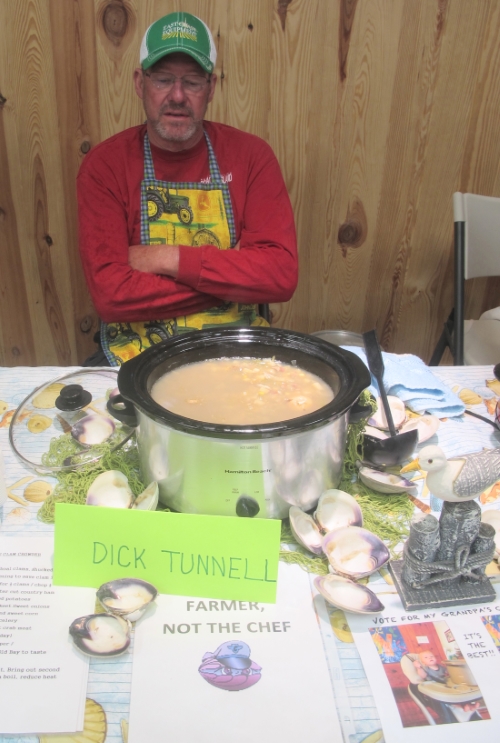
Photo: Leanne E. Smith, 4-4-2015.
Despite Dick Tunnel’s catchy signage claiming he is the “farmer, not the chef”—his attention to ingredients and process show he is, clearly, both. He grew or caught most of the ingredients, and he said, “I like to cook it several times before trying it.” His ingredients list also shared some of his process, transcribed here with some additional notes:
Dick Tunnel’s Clam Chowder
Fresh Hog Shoal clams, shucked
Fried diced center cut country ham
Diced red potatoes
Diced Mattamuskeet sweet onions
Fresh mainland sweet corn
Sliced celery
Mattamuskeet crab meat
Salt, pepper, crushed red pepper, Old Bay to taste
Freeze the clams before opening to save clam juice. Use a blender for half of clams. Chop half. Except for the crab, combine all ingredients. Put in refrigerator overnight. Bring out second day. Add crabmeat, bring to a boil, reduce heat, and serve.
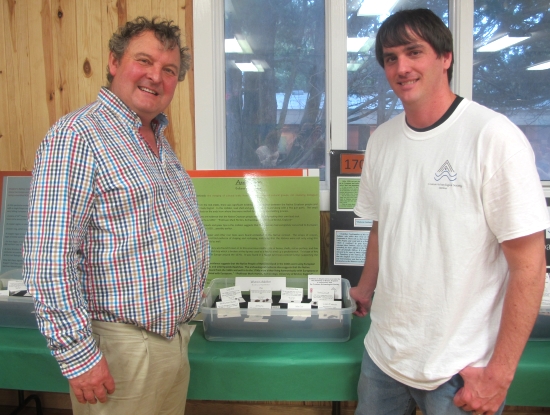
Photo: Leanne E. Smith, 4-4-2015.
When a sizeable crowd gathered and as attendee changeover occurred during the cook-off, Professor Mark Horton from the University of Bristol announced, “You’ll be some of the first people in the whole world to see it. Come have a look at some of our stuff.” What he was so enthusiastic about was a mobile museum of artifacts from Hatteras Island recently unearthed in excavation partnerships between the University of Bristol and local liaison organization Croatoan Archaeological Society.
Before official media releases due out the following week, he and Scott Dawson, CAS president, were displaying pieces they believe to be convincing evidence of Lost Colony presence on Hatteras Island. In layers of striation consistent with the Lost Colony period, they have found remnants of European travelers or even inhabitants—ingots indicating attempts at copper smelting; forged iron; pottery pieces with shell fragments, which show evidence of local craftsmanship; a ring; sewing pins (which the display posters connect to references in John Lawson’s writings about Native Americans on Hatteras wearing English-like dress); and one of the strongest finds, a Nuremburg coin matching one found at Roanoke Island.
They have been digging “next door to” where Dr. David S. Phelps’ group found a sixteenth century signet ring now housed at East Carolina University. Whereas academics have historically stripped archaeological sites of artifacts, and removed pieces of material culture from communities, Horton believes, “Ultimately, it’s not the way forward.” With CAS as a local liaison for archaeologists and community members, the current Hatteras digging project is striving to be different. The coalition has cultivated community confidence in the digs by developing plans for artifacts to remain on the Island (though they did make the day-trip to Ocracoke for display), and through years of negotiations, they have managed to gain access to private lands not explored in previous excavation projects. They have even organized some hands-on days with students at Hatteras School, and they are sharing finds via the Dig Hatteras Facebook page.
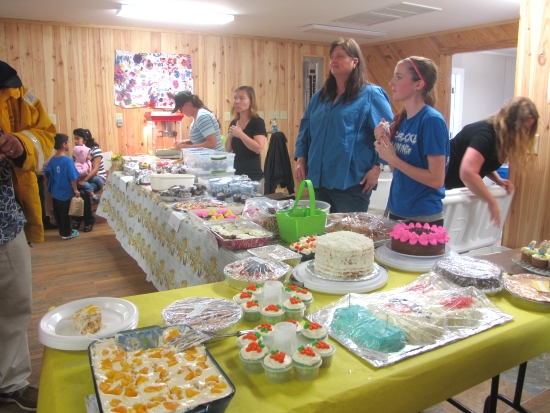
Photo: Leanne E. Smith, 4-4-2015.
Around 1 p.m., children ranging in age from 2 to 11 performed a brief Easter-themed skit they had prepared at the Ocracoke Childcare Center. Wearing pink paper ears with cotton balls glued on them and attached to paper headbands, the youth circled a neon yellow paper sun and sang “Here comes Peter Cottontail, hoppin’ down the bunny trail…” while parents and community members took photos and videos. Connie Leinbach, Ocracoke Observer editor, noted over the microphone, “This is why we’re doing it.”

Photo: Leanne E. Smith, 4-4-2015.
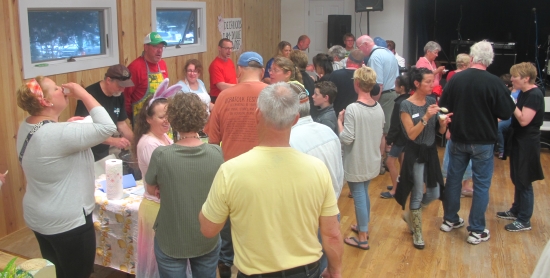
Photo: Leanne E. Smith, 4-4-2015.
In the cook-off, runners-up were the Ocracoke Post Office in the traditional category and WOVV 90.1 FM in the nontraditional category. The nontraditional winner was Sherry Atkinson’s entry for Anchorage Inn & Marina, and the traditional winner was Philip Howard and Al Scarborough’s entry for the Ocracoke Preservation Society. For any chowder left after announcing the winners around 2 p.m., bowls were sold for $5 each. One entrant jokingly asked if the remaining chowders should be combined for the by-the-bowl sale. No, they would explode, another replied, in a move for maintaining individual identity through the event.
All in the main room of the Community Center, the three-hour chowder cook-off proved to be a foodways-centered intergenerational event combining several centuries of local culture—from the centuries-old Native American and European artifacts, longtime Ocracoke family chowders, newcomers’ variations, locals, tourists, working families, retirees, plus the youth who benefit from the Childcare Center’s services. In a community where the economy is so tied to the flux of tourism and part-time and full-time residents, locally organized events like the First Annual Clam Chowder Cook-Off serve multiple roles. Short-term, the cook-off helped support immediate community needs like childcare. Long-term, though, such events help highlight the Ocracoke-style chowder among others that new residents bring with them from different traditions and from popular perceptions of what counts as clam chowder. Including the old and new together acknowledges changing community tastes while, perhaps most significantly, ensuring that the Ocracoke-rooted chowder can continue to be distinct and recognizable as a place-particular foodways tradition.
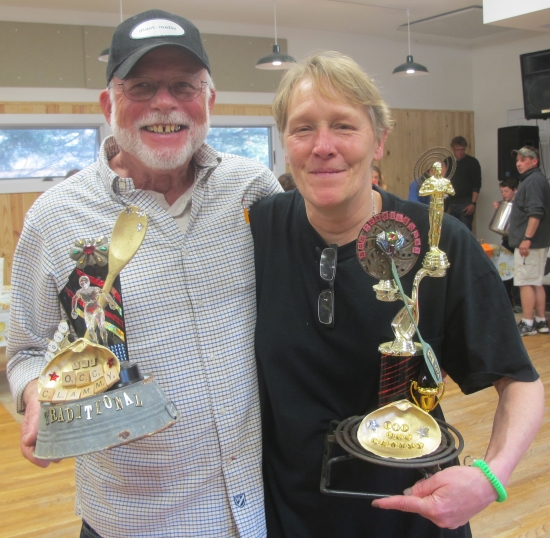
Photo: Leanne E. Smith, 4-4-2015.
…………………………………………………………..
 Leanne E. Smith, a Teaching Assistant Professor in the English Department at East Carolina University, is also active in the Folk Arts Society of Greenville and is a member of the Green Grass Cloggers. A freelance writer, editor, and photographer, she occasionally plays fiddle with Elderberry Jam, the Possum Hoppers, and Red Pen Ramblers. She is working on a book length manuscript about the Green Grass Cloggers’ 40-year history. She currently serves on the board of the North Carolina Folklore Society, and after two years as Assistant Editor of the North Carolina Folklore Journal, she was named editor in summer 2014.
Leanne E. Smith, a Teaching Assistant Professor in the English Department at East Carolina University, is also active in the Folk Arts Society of Greenville and is a member of the Green Grass Cloggers. A freelance writer, editor, and photographer, she occasionally plays fiddle with Elderberry Jam, the Possum Hoppers, and Red Pen Ramblers. She is working on a book length manuscript about the Green Grass Cloggers’ 40-year history. She currently serves on the board of the North Carolina Folklore Society, and after two years as Assistant Editor of the North Carolina Folklore Journal, she was named editor in summer 2014.
Reference
“Clam Chowder Cook-Off and Dance Coming Soon.” Ocracoke Observer. 21 March 2015. Ocracoke Observer. 4 April 2015.
Leanne Smith has documented a tasty local event and deepened our sense of local foodways, community events, and cooperation among community organizations, local people, and academic research. The Lost Colony is no longer quite as lost, and O’cokers know how to celebrate and cook up chowder. Even a dingbatter in the mountains appreciates the Island folklife Leanne describes here and her good writing.